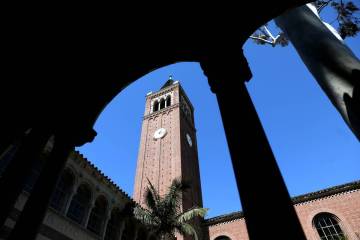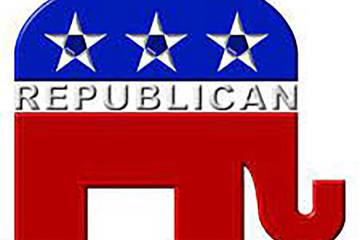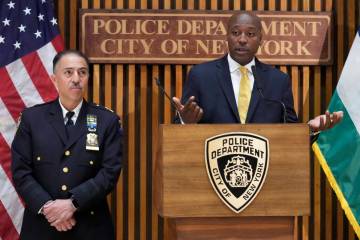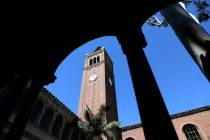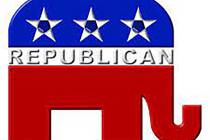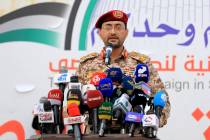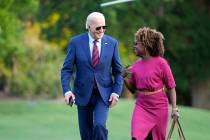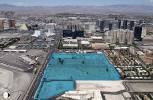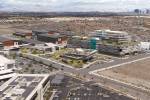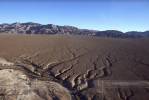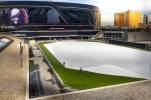Consultant offers three-pronged funding for UNLV stadium
The consultant for the University of Nevada, Las Vegas stadium board on Thursday offered a three-pronged funding approach to help build a 50,000-seat campus stadium.
Bill Rhoda, president of Plano, Texas-based CSL, identified three “buckets” of money as a buffet approach to help build the stadium — a sales tax zone that could potentially be a resort corridor; the stadium’s net income; and UNLV philanthropy.
The next step is to attach financial numbers to those three concepts, said Rick Arpin, a finance executive with MGM Resorts International, and one of 11 members on the UNLV stadium board charged with studying the proposed stadium’s funding, cost and feasibility.
CSL documents also listed taxes on live entertainment, income, property, business and slot machines as possible moneymakers.
“There will have to be some level of public participation,” Rhoda told the panel.
Another UNLV consultant, Guy Hobbs, cautioned that income and property taxes would be “problematic” to raise money for a stadium.
“When you look at the list, it becomes a very short list,” Hobbs said.
The board’s toughest challenge is figuring out how to pay for the campus stadium, which could have costs approaching $1 billion depending on the venue type and infrastructure improvements. UNLV’s proposed stadium is also competing with other planned initiatives such as the Las Vegas Convention and Visitors Authority’s $2.5 billion convention center expansion.
“The community will have to decide priorities on investments it wants to make,” said John Restrepo, a Las Vegas-based economist enlisted by CSL to determine the stadium’s economic impacts.
Several board members who represent Strip hotel-casinos also want more information about the stadium. Member Kim Sinatra, Wynn Resorts Ltd.’s general counsel, said UNLV will serve as the primary tenant, not the Las Vegas resort industry.
COSTS RISE WITH A DOME
The stadium panel is leaning informally toward a domed venue or a stadium with a sophisticated shading system. Cost projections are $714 million for a retractable-roof stadium, $664 million for a domed stadium, $514 million for an open-air stadium with a 125-foot shading system, and $490 million for an open-air stadium. CSL projects a 900,000-square-foot stadium holding 50 suites, 30 loge boxes and 2,500 club seats.
Besides dealing with the politically thorny issue of raising public dollars for the stadium, UNLV can tap private moneymakers and also raise funds. CSL also offered private stadium funding ideas such as naming rights, advertising and sponsorship deals, premium seating charges, seat licenses, donations and net income.
A closed stadium can generate $6.9 million to $8.2 million annually in naming rights and sponsorships the first five years while an open-air stadium can generate $6 million to $7.2 million a year for the same five-year period, CSL estimates.
Acting UNLV President Don Snyder, the stadium board chairman, said the tough work now begins.
“We’re at the point where the rubber is meeting the road … We’re at the toughest part of the process.”
CSL estimates that a new stadium would host 27 annual events if a closed-roof facility were built and 17 events if it’s open-air. Total attendance would range from 1.1 million for an enclosed stadium to 661,000 for open-air. Events would be UNLV football games, concerts, sports events such as rugby and soccer, and mixed martial arts fight shows.
The consultant projected annual total economic impact of $344 million for an open-air stadium and $761 million for a domed venue. For construction, CSL said there would be $859 million spent on an open-air stadium and $1.1 billion on a domed facility. A domed stadium would generate $43.3 million in all forms of annual taxes, while an open-air venue would generate $19.4 million a year, according to CSL.
The UNLV stadium board, composed of regents members, hotel-casino representatives and local officials, has to determine whether it will be an open-air or enclosed stadium and costs of construction and related infrastructure.
The stadium panel also discussed the campus’ stadium site after UNLV officials pulled the plug on the proposed location on the campus’ west side. Now, UNLV is considering a stadium site next to Thomas &Mack Center, and possibly a 42-acre site on Tropicana Avenue near Koval Lane, a short walk from campus.
Gerry Bomotti, UNLV senior vice president for finance and business, said the university has hired Las Vegas engineering firm Kimley-Horn to see whether a stadium can fit in a location next to the campus arena and whether traffic would flow effectively on a realigned Swenson Street.
“Can we create enough space to place a stadium in there?” Bomotti said.
PROCEDURE GENERATES CONCERN
Regent James Dean Leavitt, a stadium board member, said it troubled him to learn the original site was not feasible three years after the stadium process began.
“We’re doing some of this backwards,” Leavitt said. “It’s not a criticism.”
The state legislation that created the stadium board in 2013 said the panel has jurisdiction to study only stadium issues on campus, so the board cannot analyze off-campus sites as part of its report to the state legislature that is due by Oct. 1.
The stadium board next meets July 23.
Contact reporter Alan Snel at asnel@reviewjournal.com or 702-387-5273. Follow @BicycleManSnel on Twitter.






